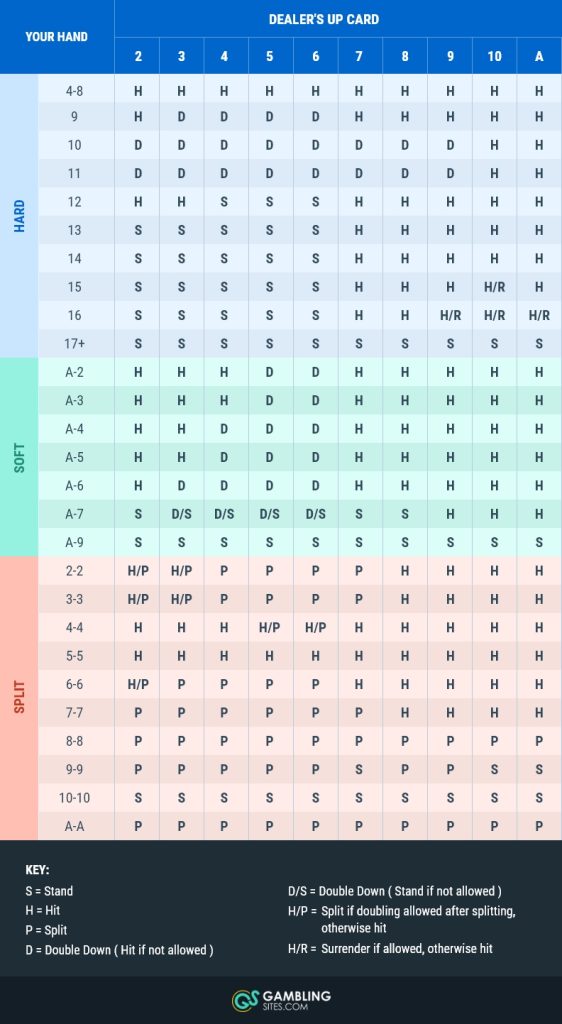- Online Casinos
- Online Betting Sites
- How to Deposit
- Gambling Site Reviews
- Gambling in My Location
 USA
USA- Alabama
- Alaska
- Arkansas
- Arizona
- California
- Colorado
- Connecticut
- Delaware
- Florida
- Georgia
- Hawaii
- Idaho
- Illinois
- Indiana
- Iowa
- Kansas
- Kentucky
- Louisiana
- Maine
- Maryland
- Massachusetts
- Michigan
- Minnesota
- Mississippi
- Missouri
- Montana
- Nebraska
- Nevada
- New Hampshire
- New Mexico
- New York
- North Carolina
- North Dakota
- Ohio
- Oklahoma
- Oregon
- Pennsylvania
- Rhode Island
- South Carolina
- South Dakota
- Tennessee
- Texas
- Utah
- Vermont
- Virginia
- Washington
- Wisconsin
- Wyoming
 Canada
Canada Australia
Australia UK
UK
- Casino of the Month
Simple Blackjack Strategy to Help You Win at Online Casinos
Looking for a simple blackjack strategy that will cut the house edge down? If so, you’re in the right place, as we’ll now present you with a couple of betting tactics that are easy to understand. More importantly, these blackjack strategies are guaranteed to work.
We will also share some blackjack tips with you, explaining how you can use them to minimize losses and ensure profits eventually.
Recommended By GamblingSites.com
This score goes to the highest rated sites by experts. Only sites that hold an expert rating of above 85% are given this status.
A green Jackpot Certified score is awarded when at least 60% of expert reviews are positive.
A red Bust score is displayed when less than 60% of expert reviews are positive.
A grayed-out gem means there are not enough expert ratings to produce a score. The gambling site could be new.
A green Jackpot Certified score means that at least 60% of player reviews are positive.
A red Bust score means that less that 59% or less of player reviews are positive.
A grayed-out face means there are not enough player reviews to produce a score.
Basic Blackjack Strategy
The best blackjack strategy is one that takes only a few minutes to master. With that knowledge, you should be able to reduce the casino edge to as little as 0.5%. We’ll now present you with a couple of such strategies, starting with the most basic one.
Go for the Blackjack
With most online blackjack games, the payout for getting 21, that is, hitting the blackjack, is 3:2 or 1.5x your bet. In comparison, winning the hand with any other card combination would result in a 1:1 payout.
This explains why most blackjack betting strategies promote aiming for 21. The simplest way to increase your chance of hitting the blackjack is to split two Aces. This way, you get two hands with 11 as the starting card. The probability of getting a 10 on either of those hands is 30.77%.
Use the Double Down Strategy
“Doubling down” is a simple blackjack strategy in which you double your bet to get one additional card. This way, you stand a chance of turning a strong hand into a much stronger one. For example, you should double down on a hard 11, especially if the dealer’s upcard is 2 through 10.
The same principle applies if you’re dealt a hard 10 and the dealer’s upcard is 4, 5, or 6. If the dealer has a low-value upcard, you can double down even on soft 16-18.
Make Use of Blackjack Insurance
Most blackjack variants found online come with an insurance option. How it works is that you place an additional bet to ensure against the possibility of the dealer hitting 21. This option is only on the table if the dealer’s upcard is an Ace. If the dealer hits the blackjack, the insurance will pay you 2:1.
With blackjack insurance, you’re basically betting against yourself, which may seem counterintuitive. However, this strategy can be very useful if you have a strong hand (e.g., 20). This way, you will make sure you win either way.
Use Blackjack Strategy Charts
Instead of memorizing all the possible scenarios, you can simply use a blackjack basic strategy chart. This is basically a table telling you what to do based on the cards you have and the upcard the dealer is dealt.
Many blackjack apps come with such tables, and you can even find a downloadable Blackjack basic strategy chart PDF somewhere on the internet.
Still, we believe that the basic strategy chart for blackjack is the one we created for you.

Top Blackjack Tips for Beginners
Here are a couple of useful tips for new blackjack players that can significantly increase their chances of winning.
- Stand on Hard 17 – A “hard 17” is a hand with the value of 17, which has no Aces that could be counted as 11. If you get such a hand (e.g., a 10 and a 7), the simple blackjack strategy tells you to stand. This could force the dealer to draw another card, thus increasing the chance of going bust.
- Hit on Soft 17 – If you get a soft 17 (e.g., Ace + 6) or any lower value, you should hit. This way, you will improve your hand without much risk of busting. If your next card is 5 or higher, the Ace will turn into 1 (rather than 11), so you’ll still have a chance to win.
- Stand with 13-16 on Dealer’s 2-6 – If your card total is between 13 and 16, you need to pay attention to the dealer’s card. If it’s 2, 3, 4, 5, or 6, you should stand. This is because the chances are that the dealer will have to draw another card, thus increasing the probability of busting. If the dealer’s card is 7 or stronger (including Ace), the advice is to hit.
- Always Split 8s – Two 8s give you a total of 16, which is one of the worst hands you can get. This is why it’s always wise to split two 8s, thus getting a new start with two separate hands.
- Never Split 10s – You should never split these two cards, as a pair of 10s equals 20, which is a hand that’s second only to the blackjack (21). The odds are in your favor, but if you want to play it safe, this is a case when you can make use of the blackjack insurance.
Card Counting in Blackjack
Card counting is a strategy blackjack players use to determine the likelihood of the next hand going in their favor. While this strategy is ineffective for virtual casino games, it can work for live blackjack.
What is Card Counting in Blackjack?
You’ve seen it in movies like Rain Man, but what exactly is card counting? By definition, this is a blackjack technique where you’re supposed to keep track of high and low cards. This way, you can get a good idea of which cards are left in the rest of the deck.
Card counting can work in brick-and-mortar casinos, but you cannot employ it in virtual blackjack. This is because generated online casino games use algorithms like the CSM (Continuous Shuffling Machine), which reshuffles the cards after every hand.
Is Card Counting Legal in Online Blackjack?
Card counting can be used in live-dealer casinos with human dealers handling the cards. It’s completely legal, as there’s no way anyone can tell you’re doing it.
The same isn’t the case with physical casinos, many of which employ security officers to spot card counters. While this activity isn’t illegal in the eyes of the law, most casinos do ban card counters.
Blackjack Card Counting Tips
If you would like to give card counting a try, here are a couple of simple tips to keep in mind.
- Assign Values to Cards – Cards 2 to 6 are “low cards” with a value of +1, cards 7 to 9 are of neutral value, while cards 10 to Ace are “high cards” with a -1 value. Using this method, calculate the total value of the cards on the table. Adjust your bet depending on the sum – if it’s a high value, increase your stake.
- Play Single-Deck Blackjack Games – The most common blackjack variants in online casinos are those that use six or eight decks. With 312 or 416 cards in the mix, such games are difficult to track, which is why card counters should look for single-deck variants.
Best Online Blackjack Betting Systems
To be successful in blackjack, you need to master the game as well as learn how to handle your gambling budget.
With that in mind, we’ve compiled a list of the best blackjack betting systems you can use.
The Martingale System
Each time you lose, you should double your stake and continue doing it until you eventually win. This way, once you win, you will recover your losses and even make a profit. For example, if you lose a $10 bet, your next bet should be $20. If you lose again, bet $40, and if you win, you’ll get $80. In this case, you’d end up with $10 extra.
The Paroli System
You can think of the Paroli system as the exact opposite of the Martingale system. With this strategy, the point is to double your stake after a winning hand. This makes it a much safer alternative to the Martingale system.
The 1-3-2-6 System
This system is designed to capitalize on winning streaks. How it works is that you need to split your entire bankroll into units. You bet one unit on the first hand, three units on the second, two on the third, and six on the fourth. However, you should only do it after winning hands. Each time you lose a hand, you should revert to the original bet, that is, one unit.
The D’Alembert System
With this strategy, too, you’re supposed to split your blackjack budget into units. Bet one unit, and if you lose, you add another unit and keep doing the same until you win. Once you win, however, you’re supposed to decrease your bet by one unit.
The Labouchere System
Also known as the cancellation betting strategy, the Labouchere System is about picking a sequence of numbers that add up to your desired profit. For example, if you want to win $100, you may go with 10-20-30-40.
For your first bet, add the first and last numbers of the sequence. In this case, it would be $50 (10 + 40). If you lose, add the amount you lose to the end of the sequence. If you win, however, cross those two numbers and start over with the next two numbers in line.
RNG Blackjack Strategy vs. Live Blackjack Strategy
RNG blackjack and live blackjack differ in that the former is based on the random number generator (RNG) software.
With the live variants, the randomness of the game is established through the dealer shuffling the cards, which allows for card counting and other strategies, as outlined in the table below.
| RNG Blackjack Strategies | Live Blackjack Strategies |
|---|---|
| Playing High-Paying Games – Different blackjack games come with different payout percentages, so look for one with 99% or over. | Card Counting – With live blackjack, card counting is possible, which isn’t the case with RNG games. |
| Taking Your Time – There’s no time limit in RNG blackjack, so you can take your time to check the blackjack strategy chart, consult a friend, etc. | Observational Techniques – You can observe the dealer/other players and adjust your bets based on their reactions. |
Blackjack Etiquette at Online Casinos
Online casinos allow you to play live blackjack from the comfort of your home. You can be as casual as you like. But there are some basic rules of etiquette you should follow to ensure a pleasant experience for yourself, the dealer, and other players.
Here are some of those:
- Don’t Argue With Fellow Players – The rule of thumb is to never offer unsolicited advice. Also, don’t type anything rude in the chat box, not just because it’s not nice, but also because you can get banned.
- Be Polite to the Dealer – In blackjack, it’s you vs. the dealer, but they’re not your enemy. This is why you should be respectful to them. If you feel like it, you can even send them a tip, as this option is available in most live casinos these days.
Gambling on Blackjack Responsibly
Like any other gambling game, blackjack is meant to be fun. What’s not fun is losing more than you can afford. Gambling at safe online casinos with a pre-determined budget is an easy way to ensure responsible gambling.
If you have trouble with sticking to the plan, you might want to look for help. People from GambleAware are there for you 24/7, ready to provide you with advice and/or point you to local help centers in your area.
Using Blackjack Strategies to Win Online
After reading this page, it’s time to put a simple blackjack strategy to good use. But which strategy should you choose? There are plenty to choose from, while the basic strategy for blackjack we wholeheartedly recommend is the use of blackjack charts.
This strategy works best with RNG blackjack, so go to a top-rated online casino like BetOnline, which has 15 such games in its collection.
This site also has a live dealer section, where you can play blackjack against human dealers and make use of card counting. Be nice to the dealer, gamble responsibly, and don’t forget to have fun!
This score goes to the highest rated sites by experts. Only sites that hold an expert rating of above 85% are given this status.
A green Jackpot Certified score is awarded when at least 60% of expert reviews are positive.
A red Bust score is displayed when less than 60% of expert reviews are positive.
A grayed-out gem means there are not enough expert ratings to produce a score. The gambling site could be new.
A green Jackpot Certified score means that at least 60% of player reviews are positive.
A red Bust score means that less that 59% or less of player reviews are positive.
A grayed-out face means there are not enough player reviews to produce a score.
 75%
75% 80%
80%
